Enhancing Ground Improvement of Dredging Landfill in South Korea’s Western Coastal Region: Insights into Dynamic Compaction Characteristics
Abstract
:1. Introduction
2. Materials and Methods
2.1. Characteristics of Soil
2.2. Soil Box Test
3. Results and Discussion
3.1. Ground Volume Change by Dynamic Compaction
3.2. Change in Excess Pore Water Pressure (EPP)
3.3. Change in Ground Strength
3.4. Analysis of Improvement Effect by Dynamic Compaction
| Researcher | Soil Type | α |
|---|---|---|
| Menard and Broise (1975) [24] | Silty sands | 0.4–0.6 |
| Mayne (1984) [32] | Silty sands | 0.5 |
| Lukas (1995) [32] | Generally soil | 0.3–0.8 |
| Lee and Kim (1996) [28] | Generally soil | 0.31–0.64 |
| Jang et al. (2009) [27] | Sands | 0.25–0.48 |
| Lee et al. (2010) [15] | Silty sands | 0.55–0.85 |
| Elreedy (2017) [33] | Finer-grained soils | 0.3–0.7 |
| Pastel (2019) [34] | Generally soil | 0.4–0.8 |
| Li et al. (2020) [29] | Sands | >0.5 |
| Zhang et al. (2021) [20] | Silty clay | 0.8 |
4. Conclusions
- The volume change caused by step-by-step pounder tamping was reduced. After the volume change of 5.47% in the third stage (Nd = 15), it converged from the fourth stage (Nd = 20). To determine the minimum number of tamping repetitions when the settlement increase is less than 10% of the total settlement, it is recommended to set the minimum number of tamping to 15, because the volume change decreases after the third stage (Nd = 15).
- The vertical and horizontal EPP changes caused by the pounder tamping decreased as the step-by-step Ev increased. Similar to the volume change, the EPP converged at the third stage (Nd = 15) or at higher stages. The dynamic compaction effect was observed up to a depth of 4.0 m vertically and 3.0 m horizontally. A comparison of the numerical analysis results and the range of ground improvement revealed that the range of ground improvement was identical to the result of the soil box test, as EPP occurred most frequently within 3.0 m. These results indicate that the ground was efficiently improved by performing step-by-step dynamic compaction with alternate tamping as much as the diameter of the pounder.
- Owing to the ground improvement effect obtained through step-by-step dynamic compaction, the static cone penetration test of the soil box was limited to a depth of 0.4 m, thus presenting a 50% reduction in the measurable depth after dynamic compaction. The cone penetration resistance at the ground surface, determined by the static cone penetration test, exhibited the maximum increase in the third stage (Nd = 15) by a factor of 1.7.
- The improvement depth coefficient (α) analyzed in the results of this study was smaller than that proposed by Menard and Broise (1975) for sandy soil ground (0.4–0.6). To maintain a constant pounder weight and tamping height and to control the efficiency of dynamic compaction, α within the range of 0.26–0.52 can be suggested. In addition, based on the soil box test results, the correlation between the number of tamping repetitions, ΔN, and the internal friction angle can be utilized to estimate the improvement effect of in situ ground and determine the in situ dynamic compaction energy.
Funding
Data Availability Statement
Conflicts of Interest
Appendix A
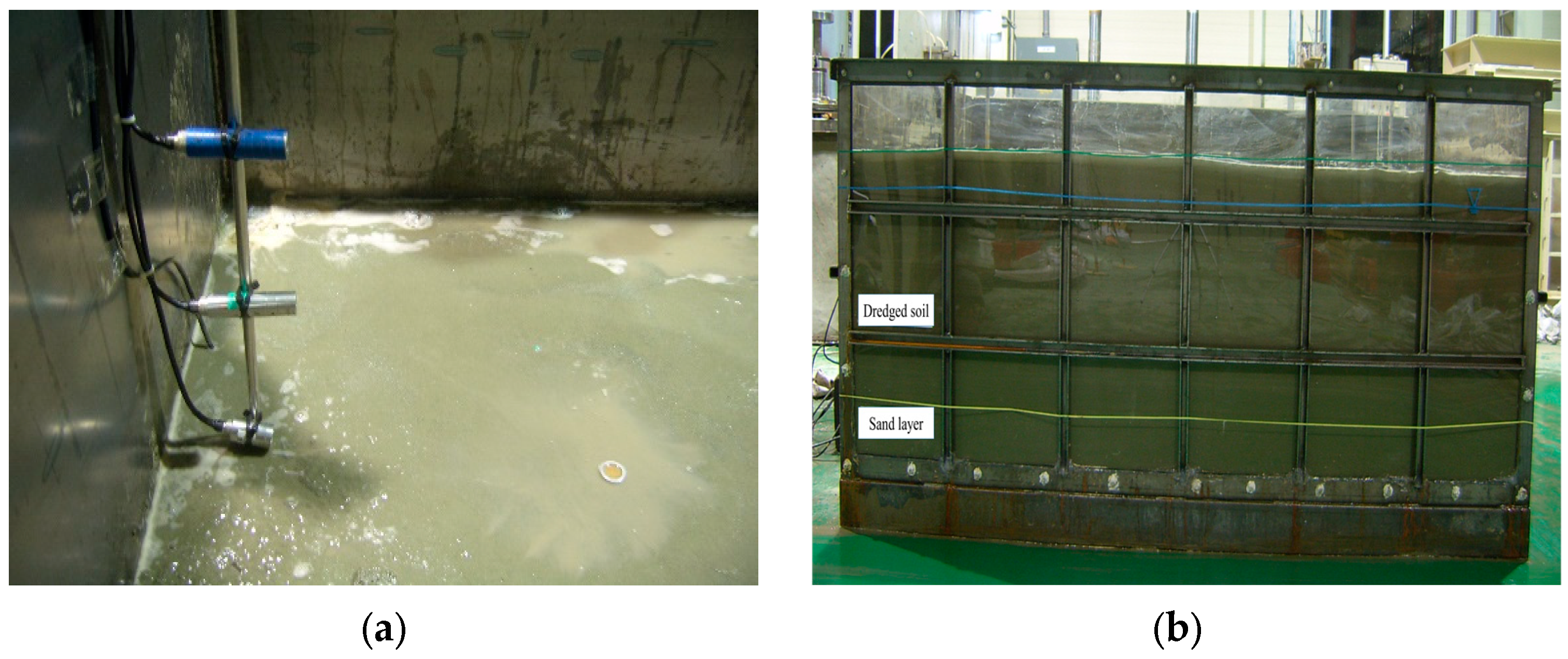
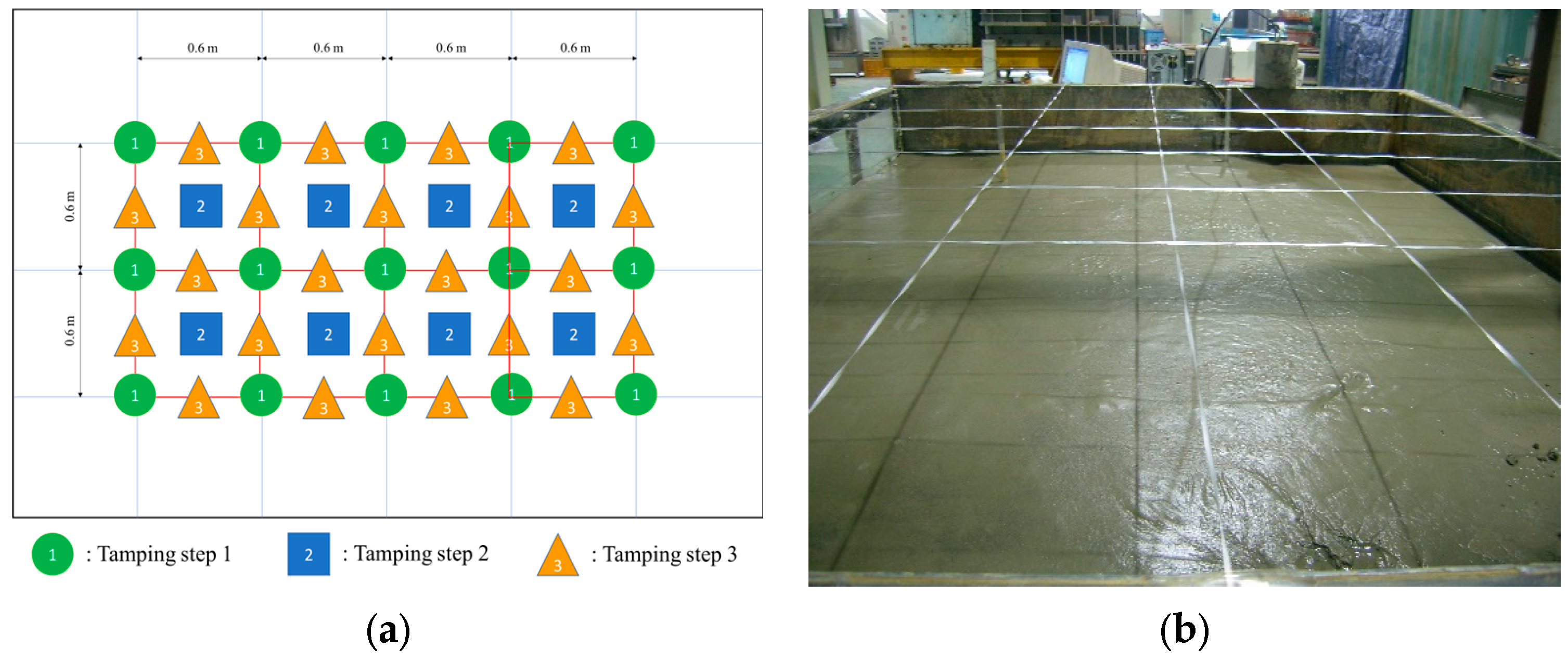
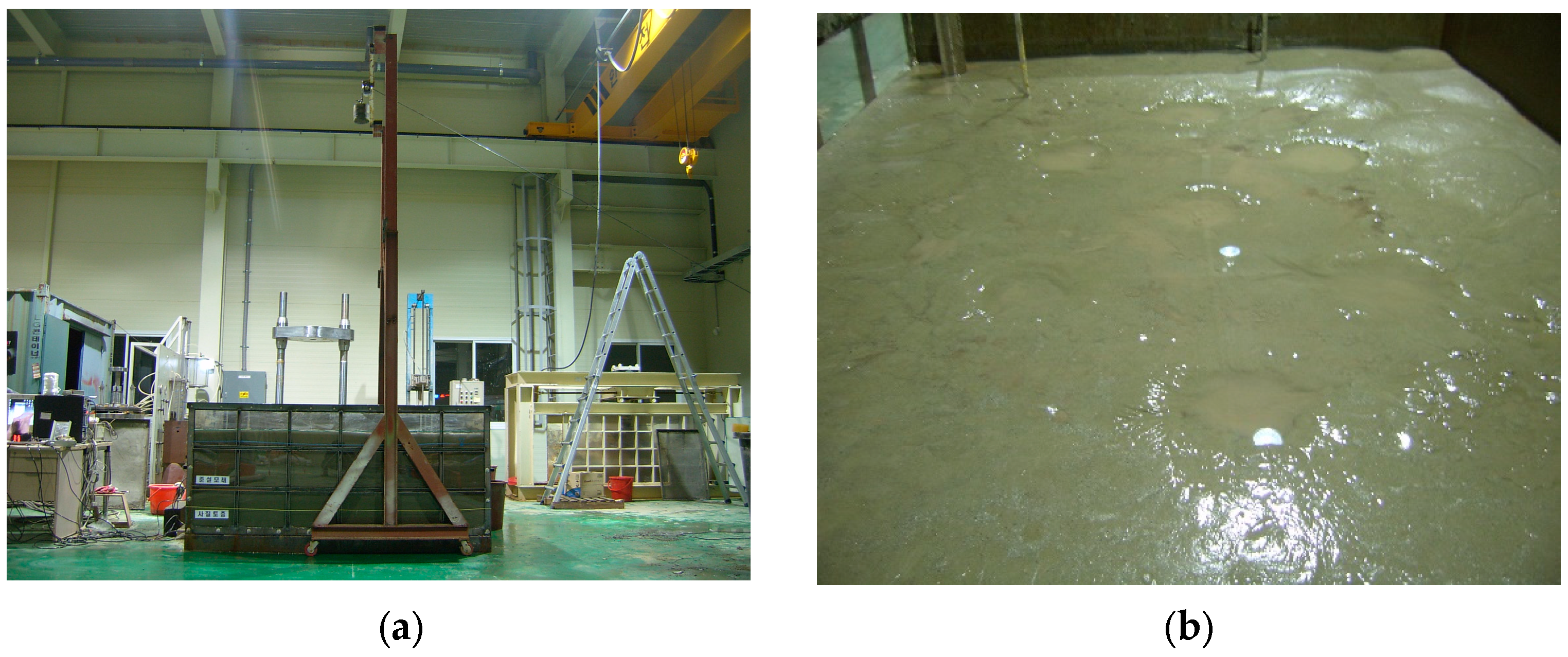

References
- Nam, H.K. A Study on the Improvement Depth of Dynamic Compaction Method Applied to Selected Soils of Waste Landfill. Doctoral Dissertation, Sangji University, Wonju, Republic of Korea, 2018. [Google Scholar]
- Hamidi, B.; Nikraz, H.; Varaksin, S. A review on impact oriented ground improvement techniques. Aust. Geomech. 2009, 44, 17–24. [Google Scholar]
- Loos, W. Comparative studies of the effectiveness of different methods for compacting cohesionless soils. In Proceedings of the 1st International Conference on Soil Mechanics and Foundation Engineering, Cambridge, MA, USA, 22–26 June 1936; Volume 3, pp. 174–179. [Google Scholar]
- Mayne, P.W.; Jones, J.S.; Dumas, J.C. Ground response to dynamic compaction. J. Geotech. Eng. 1984, 110, 757–774. [Google Scholar] [CrossRef]
- Bo, M.W.; Na, Y.M.; Arulrajah, A.; Chang, M.F. Densification of granular soil by dynamic compaction. Proc. Inst. Civ. Eng. Ground Improv. 2009, 162, 121–132. [Google Scholar] [CrossRef]
- Khelalfa, H. Dynamic compaction with high energy of sandy coastal embankment. In Proceedings of the International Symposium on Construction Management and Civil Engineering (ISCMCE, 2017), Skikda, Algeria, 15–16 November 2017. [Google Scholar]
- Ali, L.; Ali, S. Enhancement of bearing capacity by dynamic compaction: A case history. In Proceedings of the 6th International Conference on Case Histories in Geotechnical Engineering, Arlington, VA, USA, 11–16 August 2008; Volume 7.25a, pp. 1–11. [Google Scholar]
- Lee, F.H.; Gu, Q. Method for estimating dynamic compaction effect on sand. J. Geotech. Geoenviron. Eng. 2004, 130, 139–152. [Google Scholar] [CrossRef]
- Kundu, S.; Viswanadham, B.V.S. Studies to evaluate the impact of tamper on the depth of improvement in dynamic compaction. In Proceedings of the 15th Asian Regional Conference on Soil Mechanics and Geotechnical Engineering, Fukuoka, Japan, 9–13 November 2015; Japanese Geotechnical Society Special Publication: Bunkyo, Japan, 2016; Volume 2, pp. 2033–2037. [Google Scholar] [CrossRef]
- Shen, M.; Martin, J.R.; Ku, C.; Lu, Y. A case study of the effect of dynamic compaction on liquefaction of reclaimed ground. Eng. Geol. 2018, 240, 48–61. [Google Scholar] [CrossRef]
- Lee, I.M.; Kim, J.H.; Choi, Y.J. Dynamic compaction Technique for Ground Improvement: A case Study. Archit. Inst. Korea 1993, 13, 743–746. (In Korean) [Google Scholar]
- Kim, J.K.; Chae, Y.S. A Study on the Evaluation of the Effect of the Ground Improvement of Reclaimed Land Based on Dynamic Compaction Method. J. Korean Geotech. Soc. 2006, 22, 13–26. [Google Scholar]
- Lee, B.J.; Youn, J.S.; Lee, J.K. Estimation of Depth of Improvement by Dynamic Compaction with Soil Conditions. Korean Geo-Environ. Soc. 2005, 6, 55–61. [Google Scholar]
- Wrryu, W.R.; Byun, Y.S.; Lee, J.B.; Kim, K.M.; Chun, B.S. A Case Study on Shallow Foundation Design of the Reclaimed Land Based on Dynamic Compaction Method. Korean Geo-Environ. Soc. 2010, 11, 51–59. [Google Scholar]
- Lee, J.H.; Lim, D.S.; Chun, B.S. Numerical Study on the Prediction of the Depth of Improvement and Vibration Effect in Dynamic Compaction Method. J. Korean Geotech. Soc. 2010, 26, 59–66. [Google Scholar]
- Mieloszyk, E.; Milewska, A.; Wyroslak, M. Blast charge technique as a method of soil improving to locate the new supporting runways. IOP Conf. Ser. Mater. Sci. Eng. 2019, 603, 052025. [Google Scholar] [CrossRef]
- Yao, K.; Yao, Z.; Song, X.; Shang, Q. Test study of pore water pressure during dynamic compaction at the subgrade of highway in the Yellow River flood area. Adv. Mater. Res. 2012, 374–377, 436–439. [Google Scholar] [CrossRef]
- Shaban, A. Dynamic Compaction; Indian Institute of Engineering Science and Technology: Howrah, India, 2018. [Google Scholar]
- Jiang, C.; Ge, Y.; Wang, B.; Zhang, L.; Liu, Y. Impact of the High-Energy Dynamic Compaction by Multiple Compactors on the Surrounding Environment. Adv. Civ. Eng. 2021, 2021, 6643064. [Google Scholar] [CrossRef]
- Zhang, x.; Yang, M.; Han, Y. Model test study on the effect of dynamic compaction under low water content. PLoS ONE 2021, 16, e0253981. [Google Scholar] [CrossRef] [PubMed]
- Hamidi, B.; Nika, H.; Varaksin, S. Dynamic compaction vibration monitoring in a saturated site. In Proceedings of the International Conference on Advances in Geotechnical Engineering, Perth, Australia, 7–9 November 2011; pp. 267–272. [Google Scholar]
- Kim, Y.M.; Lee, S.Y.; Kim, M.G.; Shin, S.C. Assessment of dynamic deep compaction applied to waste Landfill. J. Korean Soc. Civ. Eng. 1993, 13, 209–222. (In Korean) [Google Scholar]
- ASTM D 3441-98; Standard Test Method for Mechanical Cone Penetration Tests of Soil. American Society for Testing and Materials: West Conshohocken, PA, USA, 1998.
- Menard, L.; Broise, Y. Theoretical and practical aspects of dynamic consolidation. Géotechnique 1975, 25, 3–18. [Google Scholar] [CrossRef]
- Xu, Y.; Hu, P. A pore water model of dynamic compaction. In Proceedings of the Advances in Materials, Machinery, Electrical Engineering (AMMEE 2017), Tianjin, China, 10–11 June 2017; Volume 114, pp. 1–4. [Google Scholar] [CrossRef] [Green Version]
- Bonab, M.H.; Zare, F.S. Investigation on tamping spacing in dynamic compaction using model tests. Ground Improv. 2014, 167, 219–231. [Google Scholar] [CrossRef]
- Jang, Y.S.; Song, Y.S.; Jeon, H.Y. Application of Dynamic Compaction for Finished Landfill. In Proceedings of the Korean Geotechical Society Conference, Seoul, Republic of Korea, 25–26 September 2009; pp. 1472–1477. [Google Scholar]
- Lee, S.W.; Kim, M.M. Expert System for Dynamic Compaction Method. Korean Soc. Civ. Eng. 1996, 16, 181–191. [Google Scholar]
- Li, X.; Zhang, K.; Ma, X.; Teng, J.; Zhang, S. New Method to Evaluate Strengthen Efficiency by Dynamic Compaction. Int. J. Geomech. 2020, 20, 04020024. [Google Scholar] [CrossRef]
- Meyerhof, G.G. Correlation between penetration tests and the bearing capacity of cohesionless soils. In Proceedings of the Eighth Canadian Soil Mechanics Conference, Ottawa, ON, Canada, 16–17 December 1954; pp. 12–19. [Google Scholar]
- Dunham, J.W. Pile Foundations for Buildings; American Society of Civil Engineers, Soil Mechanics and Foundation Division: Reston, VA, USA, 1954. [Google Scholar]
- Lukas, R.G. Geotechnical Engineering Circular No. 1—Dynamic Compaction; Ground Engineering Consultants, Inc.: Englewood, CO, USA, 1995. [Google Scholar]
- Elreedy, M. Onshore Structural Design Calculations: Soil Investigation and Pile Design. In Power Plant and Energy Processing Facilitie; Elsevier: Amsterdam, The Netherlands, 2017; pp. 345–385. [Google Scholar] [CrossRef]
- Patel, A. Geotechnical Investigations and Improvement of Ground Conditions: Soil compaction. In Woodhead Publishing Series in Civil and Structural Engineering; Elsevier: Amsterdam, The Netherlands, 2019; pp. 7–18. [Google Scholar] [CrossRef]
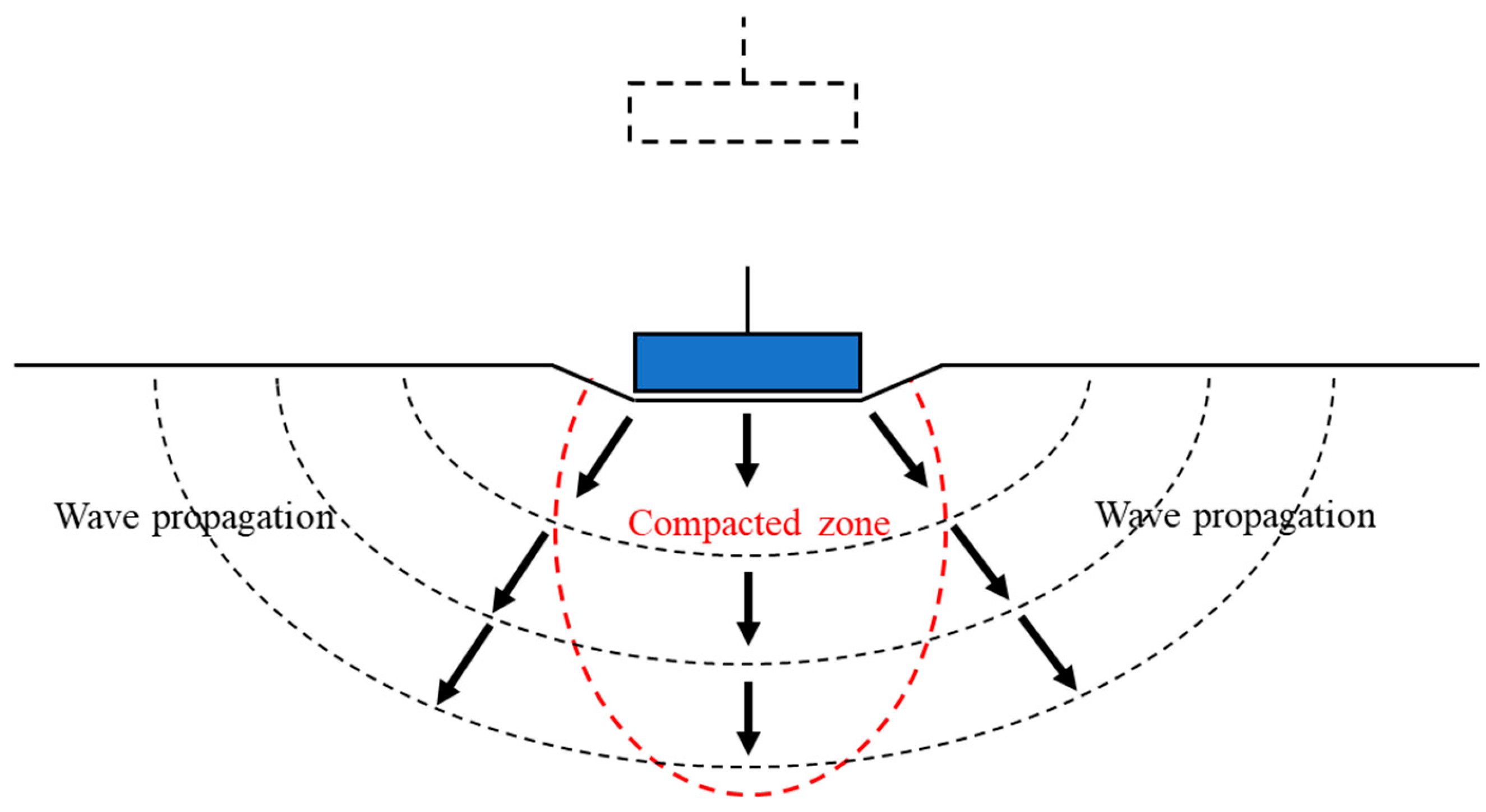

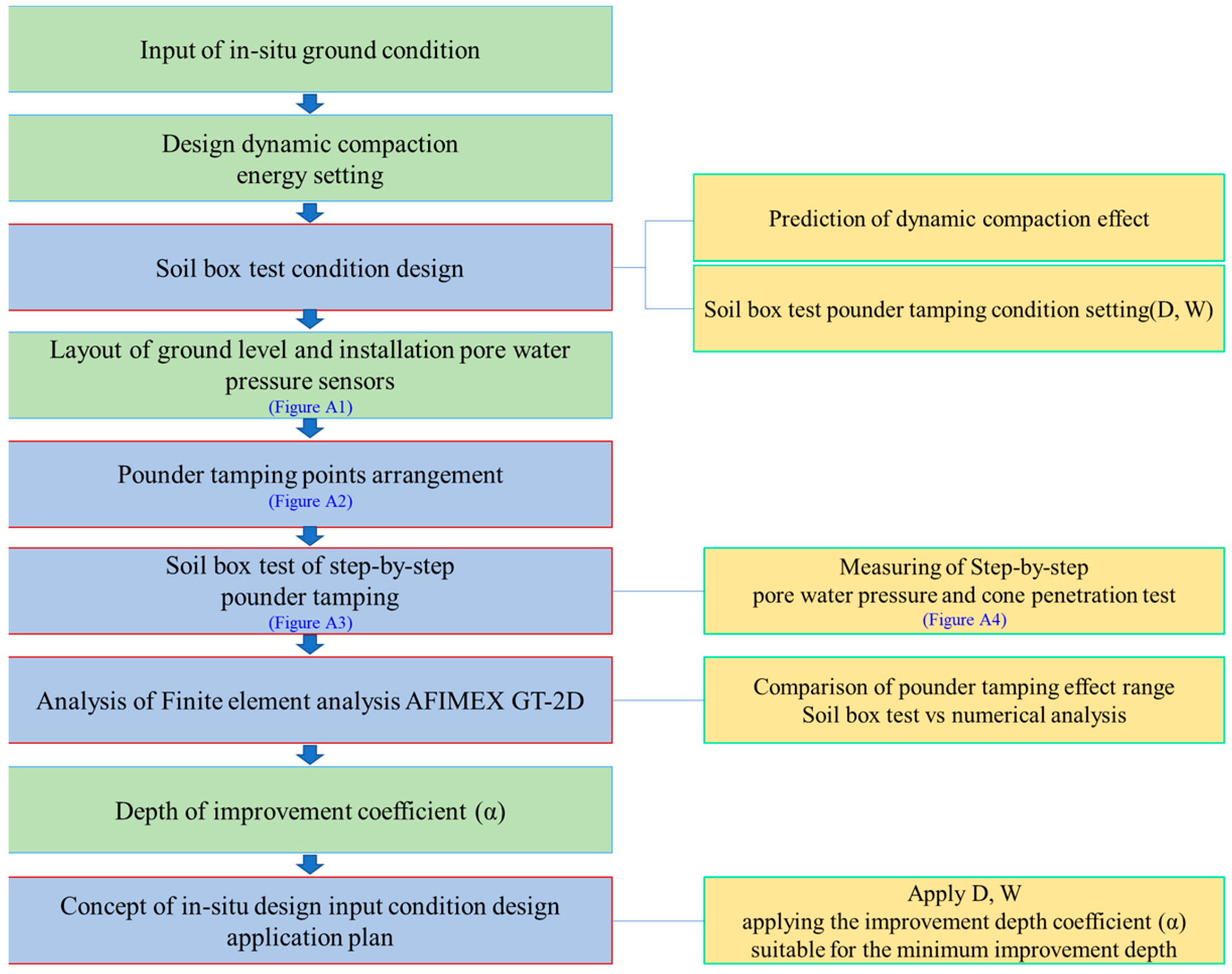
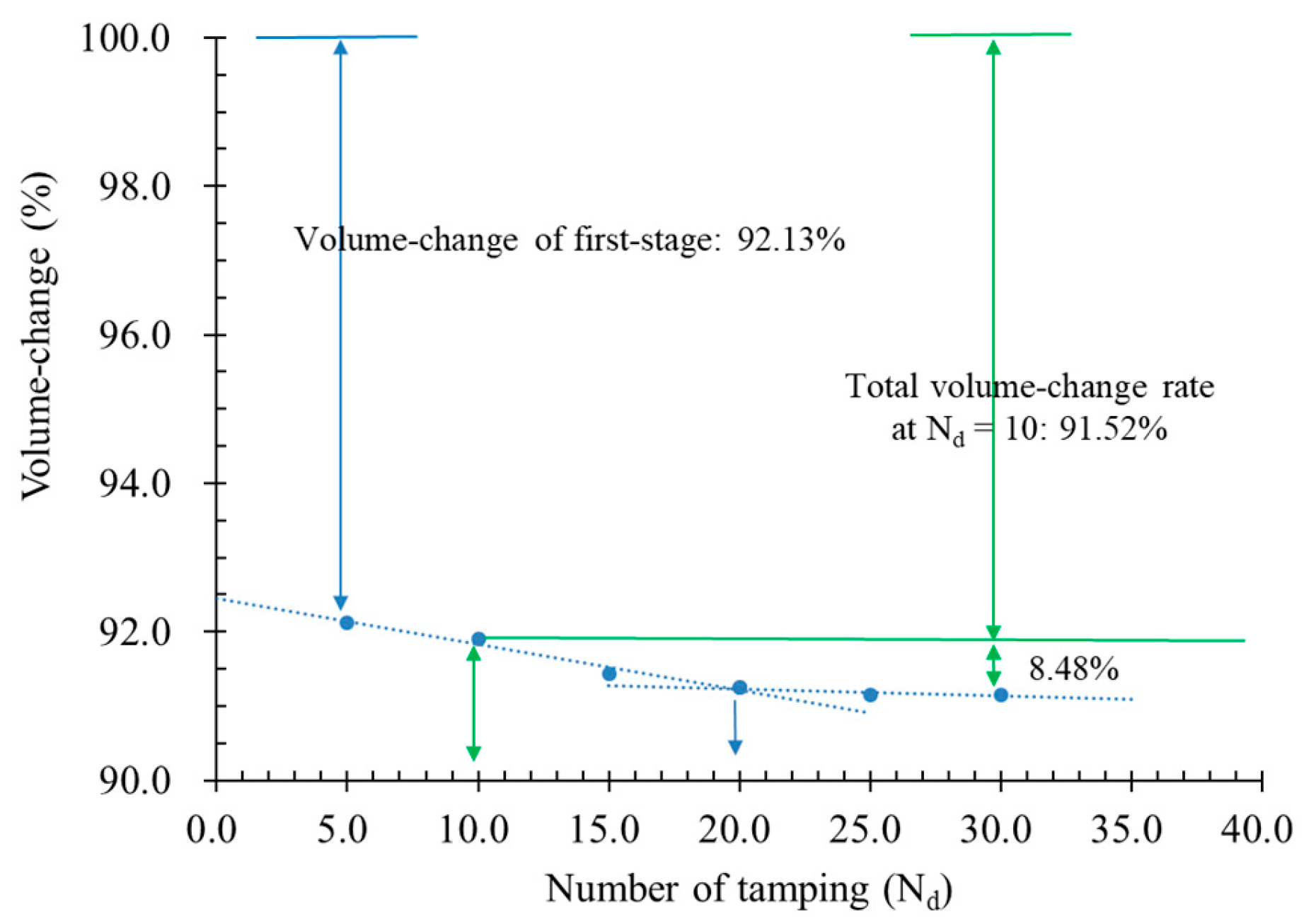
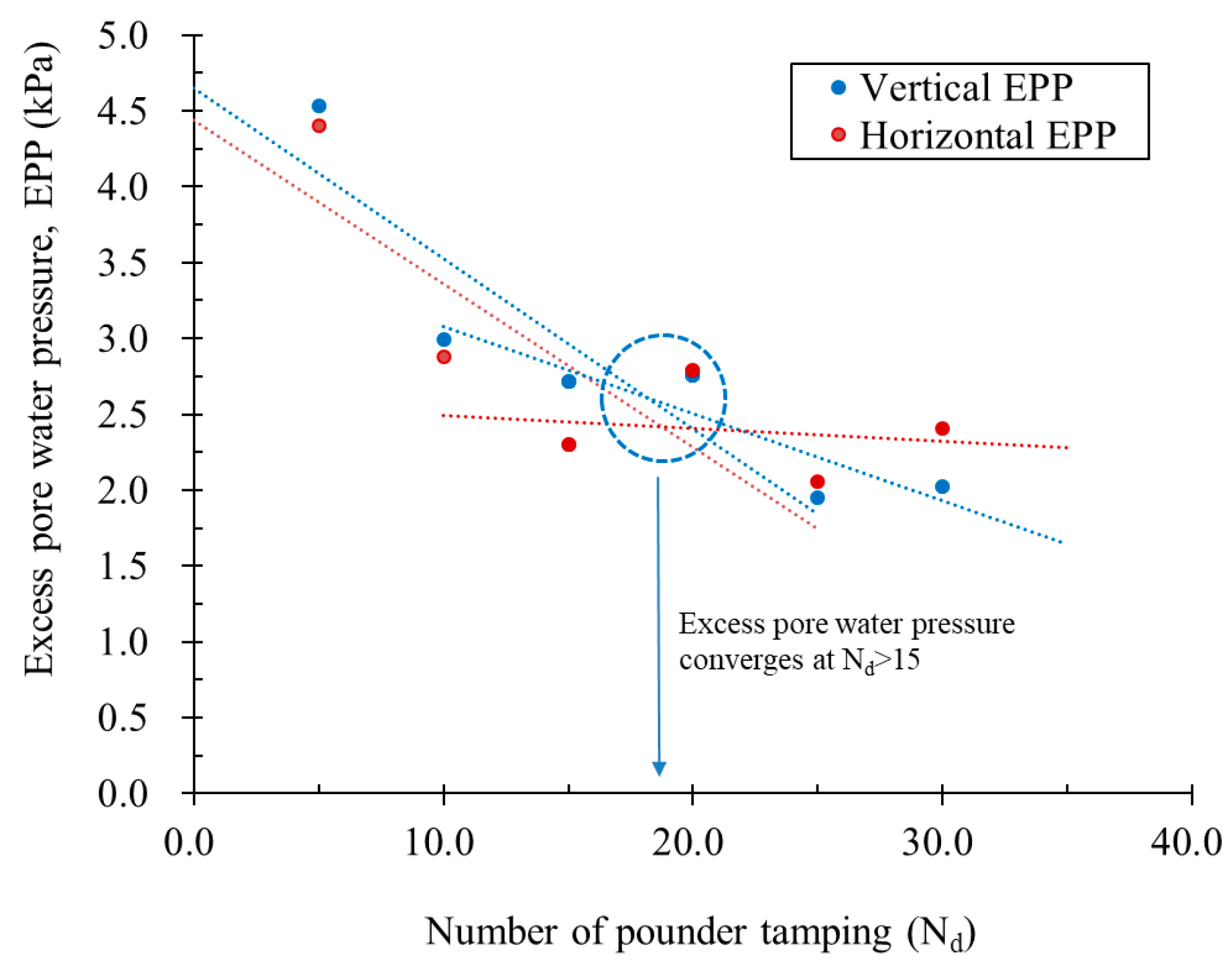


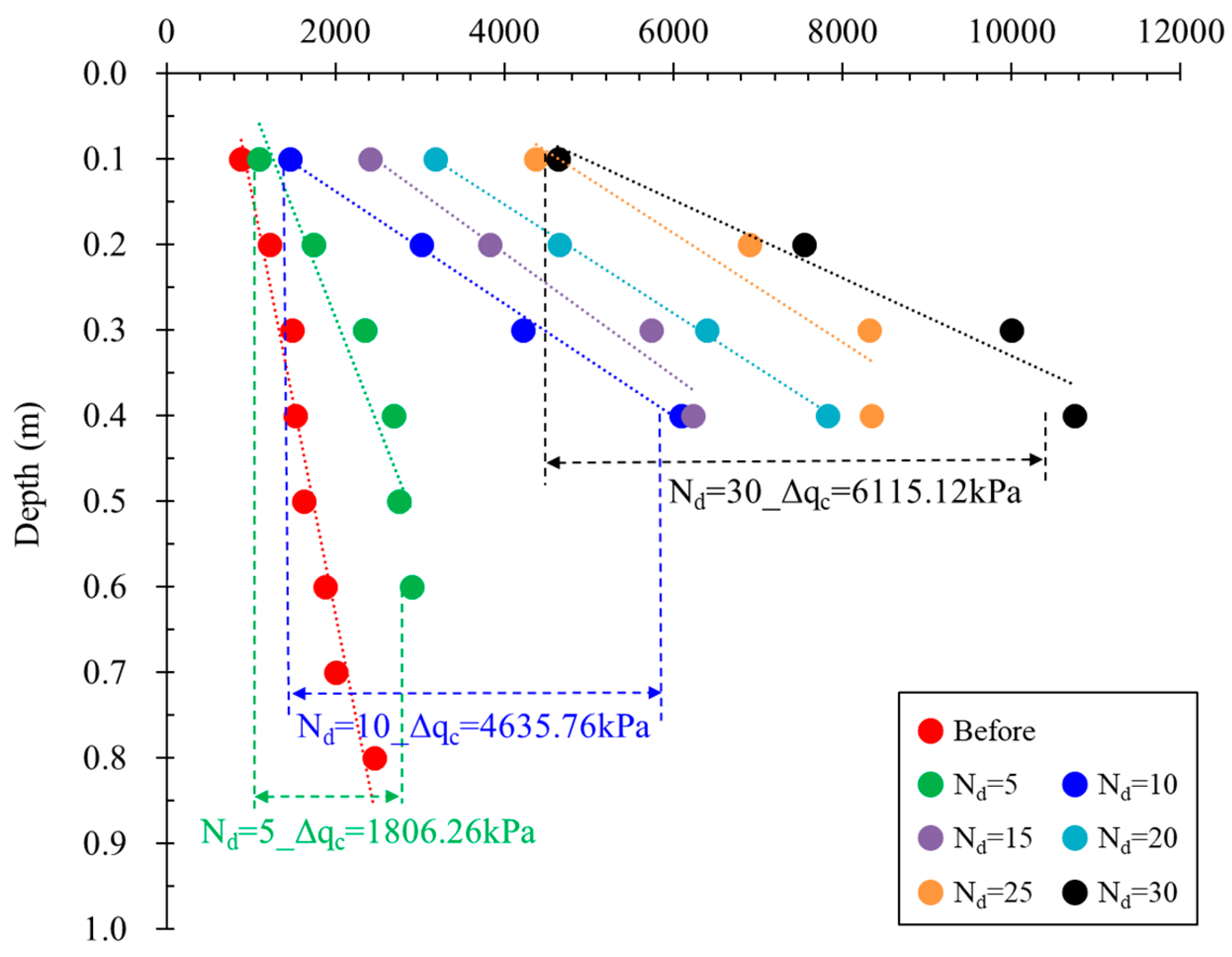

| Soil | Wn (%) | Gs | Passing through 0.075 mm | LL (%) | (kN/m3) | USCS |
|---|---|---|---|---|---|---|
| Dredged soil | 25.2 | 2.68 | 40.7 | NP | 12.34–16.82 | SM |
| Step | 1 | 2 | 3 | 4 | 5 | 6 |
|---|---|---|---|---|---|---|
| Nd = 5 | Nd = 10 | Nd = 15 | Nd = 20 | Nd = 25 | Nd = 30 | |
| Ev (kN·m/m3) | 9.8 | 20.6 | 30.4 | 41.2 | 51.0 | 61.8 |
Disclaimer/Publisher’s Note: The statements, opinions and data contained in all publications are solely those of the individual author(s) and contributor(s) and not of MDPI and/or the editor(s). MDPI and/or the editor(s) disclaim responsibility for any injury to people or property resulting from any ideas, methods, instructions or products referred to in the content. |
© 2023 by the author. Licensee MDPI, Basel, Switzerland. This article is an open access article distributed under the terms and conditions of the Creative Commons Attribution (CC BY) license (https://creativecommons.org/licenses/by/4.0/).
Share and Cite
Kim, M. Enhancing Ground Improvement of Dredging Landfill in South Korea’s Western Coastal Region: Insights into Dynamic Compaction Characteristics. Buildings 2023, 13, 1830. https://doi.org/10.3390/buildings13071830
Kim M. Enhancing Ground Improvement of Dredging Landfill in South Korea’s Western Coastal Region: Insights into Dynamic Compaction Characteristics. Buildings. 2023; 13(7):1830. https://doi.org/10.3390/buildings13071830
Chicago/Turabian StyleKim, Myeonghwan. 2023. "Enhancing Ground Improvement of Dredging Landfill in South Korea’s Western Coastal Region: Insights into Dynamic Compaction Characteristics" Buildings 13, no. 7: 1830. https://doi.org/10.3390/buildings13071830






